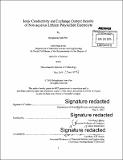Ionic conductivity and exchange current density of non-aqueous lithium polysulfide electrolyte
Author(s)
Pan, Menghsuan Sam
DownloadFull printable version (7.802Mb)
Other Contributors
Massachusetts Institute of Technology. Department of Materials Science and Engineering.
Advisor
Yet-Ming Chiang.
Terms of use
Metadata
Show full item recordAbstract
Lithium-polysulfide flow batteries, which utilize the high solubility of lithium polysulfide in non-aqueous electrolytes to enable flowable electrodes, have high theoretical energy density and low raw materials cost. To achieve greater electrode-level energy density, higher sulfur concentrations are needed. In a given electrolyte system, sulfur charge storage capacity (e.g. mAh/g sulfur) decreases dramatically with increasing sulfur concentration at a fixed C-rate, which corresponds to higher current output in higher concentration system. Understanding the limiting factors that undercut the rate capacity is crucial to enhancing the performance of high energy density systems. In particular, we systematically investigate the ionic conductivity and exchange current density at the electrode surface with lithium polysulfide solutions of varying concentration and in differing solvents which solvent molecules of different sizes. Ionic conductivities are measured using a commercially available conductivity probe, while exchange current densities are measured using both impedance spectroscopy and galvanostatic polarization using glassy carbon working electrodes. The electrolyte solvent is found to dramatically affect the solution ionic conductivity and exchange current density. In the concentration range of interest (1-8 M [S]), the ionic conductivity monotonically decreases with increasing sulfur concentration while exchange current density shows a more complicated response in a given solvent system. Between solvent systems, we observed a five-fold increase in ionic conductivity, and a more than 15-fold enhancement in exchange current density. The conductivity and current density results are used to interpret the rate capability of suspension-based cells using lithium-polysulfide electrolyte and carbon black as the cathode with different solvents. With the improvement in kinetics parameters, we also observed better rate capability in solvent. We also study non-carbonaceous electrode materials to understand how the electrode material can affect exchange current density and thus cell capacity. Indium tin oxide electrode shows lower exchange current density then glassy carbon electrode in preliminary results.
Description
Thesis: S.B., Massachusetts Institute of Technology, Department of Materials Science and Engineering, June 2015. Cataloged from PDF version of thesis. "May 2015." Includes bibliographical references (pages 32-33).
Date issued
2015Department
Massachusetts Institute of Technology. Department of Materials Science and EngineeringPublisher
Massachusetts Institute of Technology
Keywords
Materials Science and Engineering.